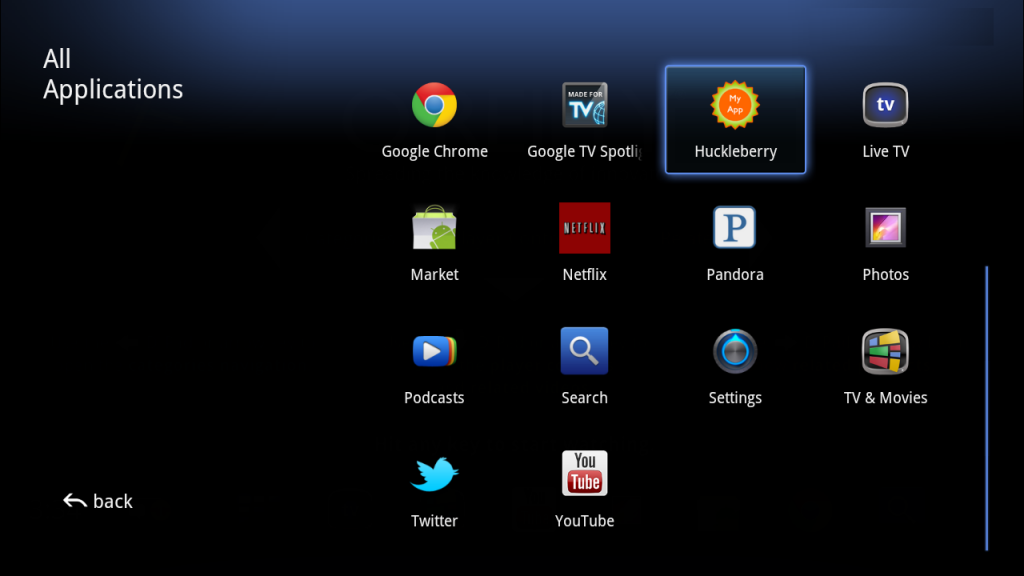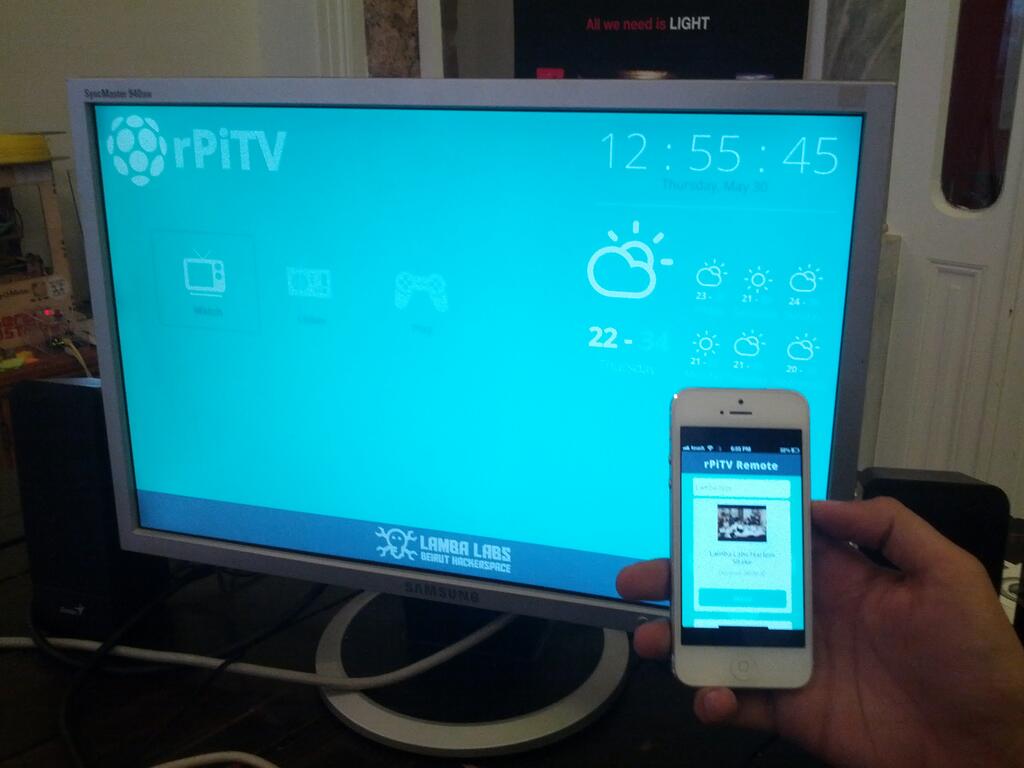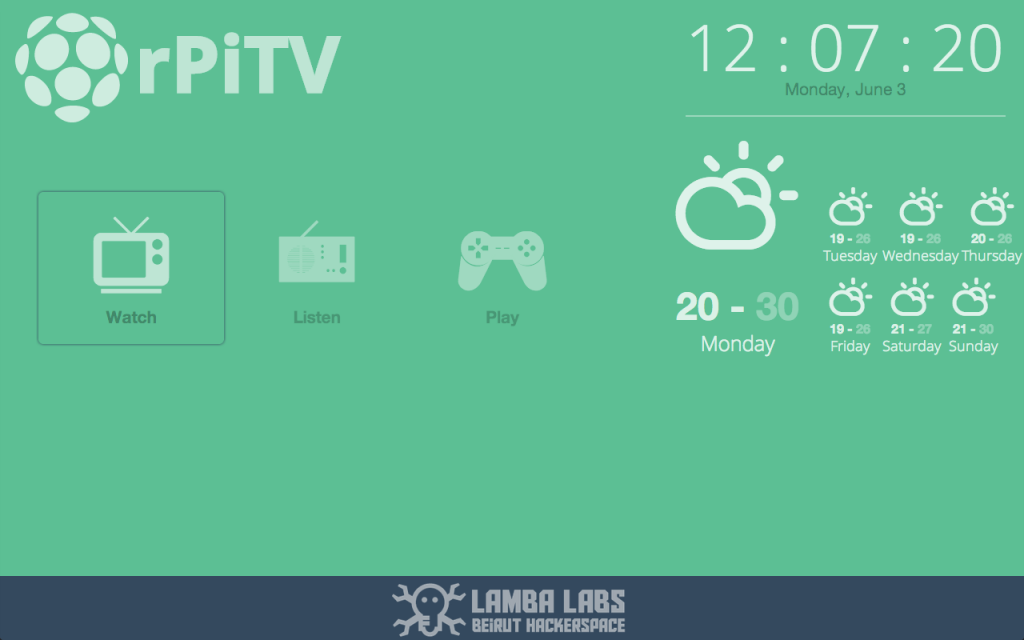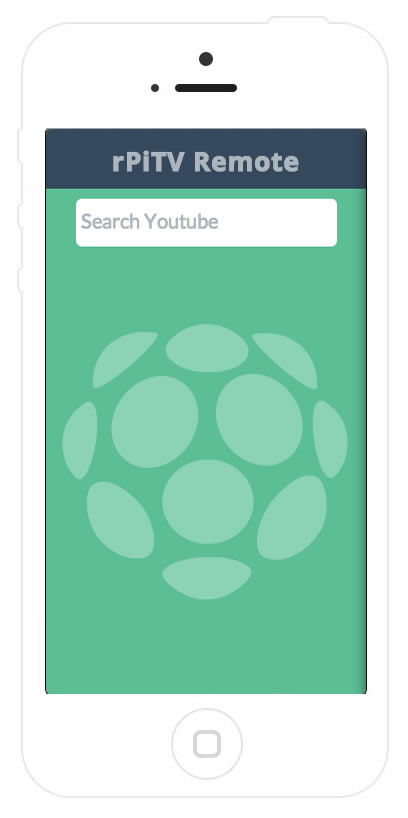Codementor Donald Derek is a conference speaker, an open-source advocate, a maker and an activist. He organizes, facilitates, and mentors startup events, and has also personally won several awards for his projects, includingn!mp, a SoundCloud + Jamendo Music player with a web mobile remote app, and meeneeme, a Tamagotchi game based on your Foursquare checkins. He is currently a researcher at the MIT Media Lab – Responsive Environments.
Donald has also created the RaspberryPi-Tv, in which he shares with us a tutorial on how to build your own Google TV with it. This article was originally posted at his blog.

Please note that this project is not intended to replicate an actual GoogleTV, but it’s simply a proof of concept using modern web technologies.
Watch the full workshop here hosted by Menaversity
This workshop was given at Lamba Labs Beirut First Hackerspace
after a series of lightning talks check out the presentation here
If you'd like to bypass the tutorial and jump into the fun stuff, you can always fork the code on Github
What’s Google TV ?
Turned out that Google is also doing its own thing for the 10-foot screen. Google announced 2 versions of their famous new TV, the first is called the Buddy Box which is currently an expensive box manufactured by Sony and the second is an Integrated TV built right into the TV set that will be announced soon.
The Google TV looks something like that:

Developers: you can start building your own Web Apps for the Google TV or renovate any android app to fit the 10′ experience, all the resources can be found at Google’s Developers Site
Build your own Google TV
In this tutorial you’re going to build your own version of the Google TV using the following open source technologies:
Hardware:
- The RaspberryPi
Software Stack:
- Raspbian OS – a Debian distro specially made for the rPi
- NodeJs
- Socket.io – to handle the connection between our remote and our TV via websockets
- Express – to handle some basic http requests
- Omxcontrol – a simple module to control the OMXPlayer which is the best video player on the rPi
- Chromium Browser
- OMXPlayer
- Youtube-dl – a script that let you download youtube videos
- QuoJS – to handle swipe gestures on the mobile web app
- HTML5, CSS3 transitions, Javascript, and Moustache as a template engine
- Youtube API
The end result

Walkthrough
The project is divided into 4 main categories:
- Installing the software stack
- Basic shell commands & scripts
- Building the back-end: NodeJS + Express + Socket.io
- Building the front-end: Dashboard and Remote App
1.Installing the software stack:
Install Raspbian & NodeJS
Follow this tutorial to install Raspbian and Node Js on your Raspberry Pi
Install Chromium & Youtube-dl
Install Chromium Browser for the Raspberry Pi Source
sudo apt-get install chromium-browser
In order to have a better display you can also install MC core fonts using
sudo apt-get install ttf-mscorefonts-installer
Install and Update Youtube Downloader
sudo apt-get install youtube-dl
sudo youtube-dl -U
2.Basic shell commands & scripts
If you’re using SSH to connect to your RaspberryPi you should first add “DISPLAY=:0.0″ to your env variables, by simply executing
export DISPLAY=:0.0
To check all your environment variables
env
Test Chromium in Kiosk Mode:
chromium --kiosk http://www.google.com
Test Youtube-dl
youtube-dl youtube_video_url
I’ve added few arguments to the youtube-dl command to change the name of the downloaded file to be just the “-o youtube ID [dot] the extension” and with the “-f /22/18 ” I can force this script to download for me a 720p version of the video. Check out the full list of supported youtube formats here
youtube-dl -o "%(id)s.%(ext)s" -f /22/18 youtube_video_url
After downloading the video, try playing it using OMXPLayer
omxplayer youtube_video_file
Have fun trying the keyboard shortcuts to pause/resume your video and a lot more
Fancy! Let’s automate this process using Node JS
Building the backend: NodeJS + Express + Socket.io
The source code is intended to be simple for the sake of the workshop. Here’s the project’s hierarchy:
- public
- js
- css
- images
- fonts
- index.html
- remote.html
- app.js
- package.json
Package.json – A JSON file needed by npm to auto-install dependencies and save some basic info about your project
{
"name": "RasPi.TV",
"version": "0.0.1",
"private": false,
"scripts": {
"start": "node app.js"
},
"dependencies": {
"express": "3.1.1",
"socket.io":"0.9.14",
"omxcontrol":"*"
}
}
after creating this file, go to your app directory and run the following to install the dependencies.
npm install
Create the app.js file and lets start by creating our basic HTTP Express Server
var express = require('express')
, app = express()
, server = require('http').createServer(app)
, path = require('path')
// all environments
app.set('port', process.env.TEST_PORT || 8080);
app.use(express.favicon());
app.use(express.logger('dev'));
app.use(express.bodyParser());
app.use(express.methodOverride());
app.use(express.static(path.join(__dirname, 'public')));
//Routes
app.get('/', function (req, res) {
res.sendfile(__dirname + '/public/index.html');
});
app.get('/remote', function (req, res) {
res.sendfile(__dirname + '/public/remote.html');
});
server.listen(app.get('port'), function(){
console.log('Express server listening on port ' + app.get('port'));
});
This is our basic Express HTTP server configuration with our routes. To test what’ve done so far, you should first create the index.html and remote.html files inside the public/ directory, write your favorite “Hello, World” messages into them, then go back to your terminal and execute
node app.js
or
npm start...
"scripts": {
"start": "node app.js"
},
...
Once your server starts it will output that Express server listening on port 8080
To test your “Hello, World” pages you should run this application in the background by simply doing
To test your “Hello, World” pages you should run this application in the background by simply doing
node app.js &
Now this is the most primitive way to launch a Node application in the background, while learning node you might bump into some modules that automates this simple task, just like Forever.js
Now we have our Node Application up and running in the background, let’s open chromium in kiosk mode and test our Hello, World pages.
chromium --kiosk http://localhost:8080Adding the Socket.io Magic
I strongly believe that WebSockets are the foundation of the modern web, I always like to point out the following analogy that helped me understand Socket.io
When AJAX first popped out, old skool developers felt its magic, but they’ve encountered many problems due to how different browsers handle Asynchronous JavaScript and XML requests. jQuery came with the solution by providing a nice and minimal set of functions to deal with the browsers nightmare. Socket.io did the same but for WebSockets and even more!
In order to provide realtime connectivity on every browser, Socket.IO selects the most capable transport at runtime, without it affecting the API.
- WebSocket
- Adobe® Flash® Socket
- AJAX long polling
- AJAX multipart streaming
- Forever Iframe
- JSONP Polling
In order to integrate Socket.io we should add the following to our app.js file:
var express = require('express')
, app = express()
, server = require('http').createServer(app)
, path = require('path')
, io = require('socket.io').listen(server)
, spawn = require('child_process').spawn
and to minify the logs add this:
//Socket.io Config
io.set('log level', 1);
When developing with Socket.io always think like you’re creating a Hello, World Chat Application. I’ve added a simple Chat Application done with Node & Socket.io on a github repo for the sake of this tutorial!
Our Socket.io Server is ready, but it doesn’t do anything, we should implement how we process messages and events sent from the client to the server.
Here’s how you implement this on the server’s side, note that you should also implement how you handle messages on the client’s side, we will see that as we progress throughout this tutorial.
io.sockets.on('connection', function (socket) {
socket.emit('message', { message: 'welcome to the chat' });
socket.on('send', function (data) {
//Emit to all
io.sockets.emit('message', data);
});
});
Now our server Emits the message “message” whenever a new client is connected, and waits for an event name “send” to process the data and emit it back to all connected clients
In our case We have two types of clients: The RaspberryPi Display (Screen) and the Mobile Web Application (Remote)
var ss;
//Socket.io Server
io.sockets.on('connection', function (socket) {
socket.on("screen", function(data){
socket.type = "screen";
//Save the screen socket
ss = socket;
console.log("Screen ready...");
});
socket.on("remote", function(data){
socket.type = "remote";
console.log("Remote ready...");
if(ss != undefined){
console.log("Synced...");
}
});
)};
Client Side Sockets Handeling
inside remote.html we should have the following:
<script src="/socket.io/socket.io.js"> </script>
<script>
//use http://raspberryPi.local if your using Avahi Service
//or use your RasperryPi IP instead
var socket = io.connect('http://raspberrypi.local:8080');
socket.on('connect', function(data){
socket.emit('screen');
});
</script>
On our index.html
<script src="/socket.io/socket.io.js"> </script>
<script>
//use http://raspberryPi.local if your using Avahi Service
//or use your RasperryPi IP instead
var socket = io.connect('http://raspberrypi.local:8080');
socket.on('connect', function(data){
socket.emit('screen');
});
</script>
Execute Shell Commands from Node Server
Node enables us to run a system command within a new child process, and listen in on its input/output. This includes being able to pass arguments to the command, and even pipe the results of one command to another.
The basic way of executing shell commands from NodeJS is very simple
spawn('echo',['foobar']);
But if you want to pipe in the output, you should add the following function to your app.js file:
//Run and pipe shell script output
function run_shell(cmd, args, cb, end) {
var spawn = require('child_process').spawn,
child = spawn(cmd, args),
me = this;
child.stdout.on('data', function (buffer) { cb(me, buffer) });
child.stdout.on('end', end);
}
Adding OMXControl – the OMXPlayer controller Node Module
Luckily I found a node module on npmjs.org that let you control your OMXPlayer using Express!
just add the following to your app.js file to use it.
just add the following to your app.js file to use it.
var omx = require('omxcontrol');
//use it with express
app.use(omx());
This will create for us the following routes, that we can use to control and play our videos:
http://localhost:8080/omx/start/:filename
http://localhost:8080/omx/pause
http://localhost:8080/omx/quit
Pretty Awesome!
Putting it all together
Our evolved app.js file
/**
* Module dependencies.
*/
var express = require('express')
, app = express()
, server = require('http').createServer(app)
, path = require('path')
, io = require('socket.io').listen(server)
, spawn = require('child_process').spawn
, omx = require('omxcontrol');
// all environments
app.set('port', process.env.TEST_PORT || 8080);
app.use(express.favicon());
app.use(express.logger('dev'));
app.use(express.bodyParser());
app.use(express.methodOverride());
app.use(express.static(path.join(__dirname, 'public')));
app.use(omx());
//Routes
app.get('/', function (req, res) {
res.sendfile(__dirname + '/public/index.html');
});
app.get('/remote', function (req, res) {
res.sendfile(__dirname + '/public/remote.html');
});
//Socket.io Congfig
io.set('log level', 1);
server.listen(app.get('port'), function(){
console.log('Express server listening on port ' + app.get('port'));
});
//Run and pipe shell script output
function run_shell(cmd, args, cb, end) {
var spawn = require('child_process').spawn,
child = spawn(cmd, args),
me = this;
child.stdout.on('data', function (buffer) { cb(me, buffer) });
child.stdout.on('end', end);
}
//Save the Screen Socket in this variable
var ss;
//Socket.io Server
io.sockets.on('connection', function (socket) {
socket.on("screen", function(data){
socket.type = "screen";
ss = socket;
console.log("Screen ready...");
});
socket.on("remote", function(data){
socket.type = "remote";
console.log("Remote ready...");
});
socket.on("controll", function(data){
console.log(data);
if(socket.type === "remote"){
if(data.action === "tap"){
if(ss != undefined){
ss.emit("controlling", {action:"enter"});
}
}
else if(data.action === "swipeLeft"){
if(ss != undefined){
ss.emit("controlling", {action:"goLeft"});
}
}
else if(data.action === "swipeRight"){
if(ss != undefined){
ss.emit("controlling", {action:"goRight"});
}
}
}
});
socket.on("video", function(data){
if( data.action === "play"){
var id = data.video_id,
url = "http://www.youtube.com/watch?v="+id;
var runShell = new run_shell('youtube-dl',['-o','%(id)s.%(ext)s','-f','/18/22',url],
function (me, buffer) {
me.stdout += buffer.toString();
socket.emit("loading",{output: me.stdout});
console.log(me.stdout)
},
function () {
//child = spawn('omxplayer',[id+'.mp4']);
omx.start(id+'.mp4');
});
}
});
});
Building the front-end

Describing in details how I built the front-end is outside the scope of this tutorial, however I would like to point out few tips that I discovered while doing this project over the weekend.
When designing for the 10′ Screen there’s some design considerations that you should follow, Google assembled a nice set of these standards on their Developers Site

raspberry pi remote
Instead of creating a typical remote, full of fake buttons, I decided to give QuoJS a try, it’s really fantastic and easy to use!
$$(".r-container").swipeLeft(function(){
socket.emit('control',{action:"swipeLeft"});
});
Here’s an example of how I send the message “Control” back to the server with the data action:”swipeLeft”
the server will handle that message by sending it to the screen, the screen client will handle this message by moving the selected square to the next app (Watch, Listen, Play)
the server will handle that message by sending it to the screen, the screen client will handle this message by moving the selected square to the next app (Watch, Listen, Play)
I’ve also stumbled upon few trick that will let your iPhone mobile web app look like a native one with a nice icon and a splash screen.
Just add the following to your HTML <head></head> blocks
Just add the following to your HTML <head></head> blocks
<link rel="apple-touch-icon" href="images/custom_icon.png"/>
<link rel="apple-touch-startup-image" href="images/startup.png">
<meta name="viewport" content="width=device-width initial-scale=1, maximum-scale=1, user-scalable=no" />
<meta name="apple-mobile-web-app-title" content="Remote">
<meta name="apple-mobile-web-app-capable" content="yes">Wrap-up
This project is still a work in progress, updates coming soon. If you liked this tutorial please don’t forget to check the source code on Github and show some love by starring it .
I never thought I will come in contact with a real and potential hacker until I knew brillianthackers800 at Gmail and he delivered a professional job,he is intelligent and understanding to control jobs that comes his way
ReplyDeleteContact him and be happy
i am a successful business owner and father. I got one of these already programmed blank ATM cards that allows me withdraw a maximum of $5,000 daily for 30 days. I am so happy about these cards because I received mine last week and have already used it to get $20,000. Skylink technology is giving out these cards to support people in any kind of financial problem. I must be sincere to you, when i first saw the advert, I believed it to be illegal and a hoax but when I contacted this team, they confirmed to me that although it is illegal, nobody gets caught while using these cards because they have been programmed to disable every communication once inserted into any Automated Teller Machine(ATM). If interested get through to them on mail: skylinktechnes@yahoo.com or whatsapp/telegram: +1(213)785-1553
ReplyDelete